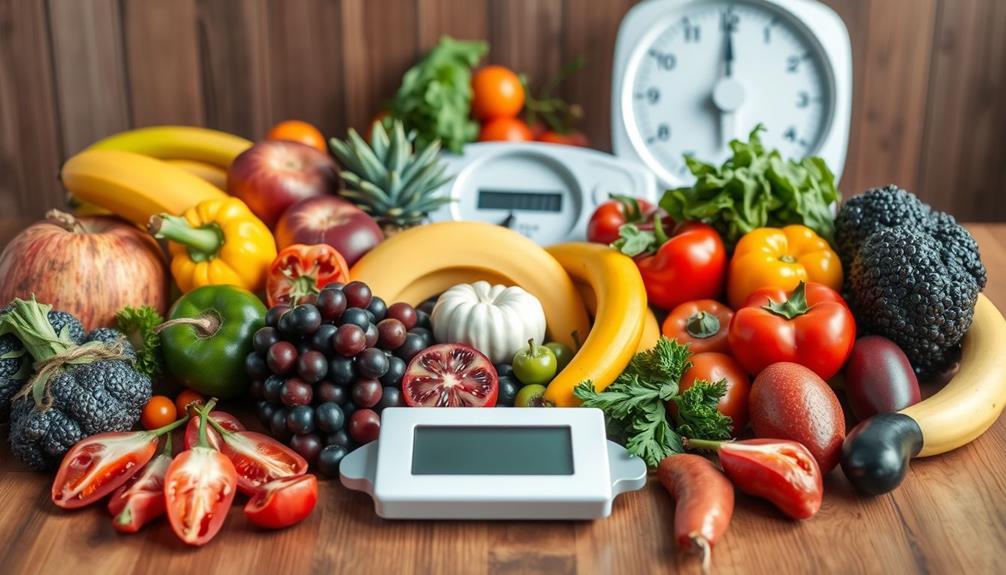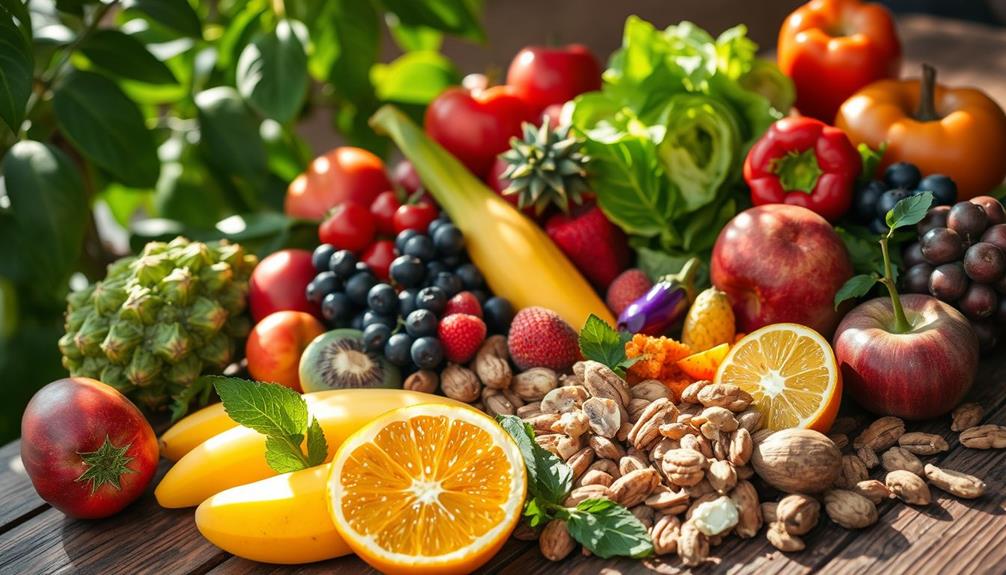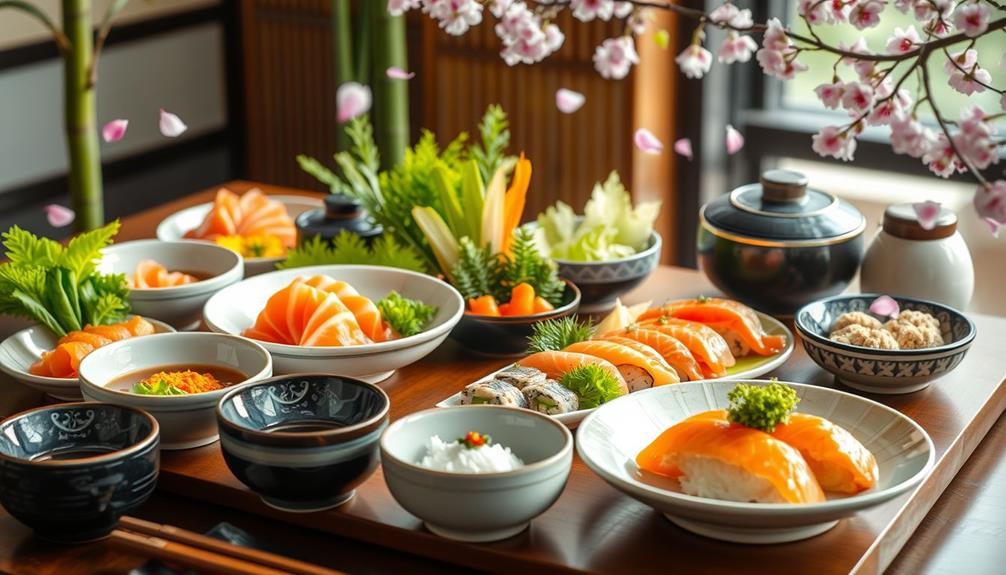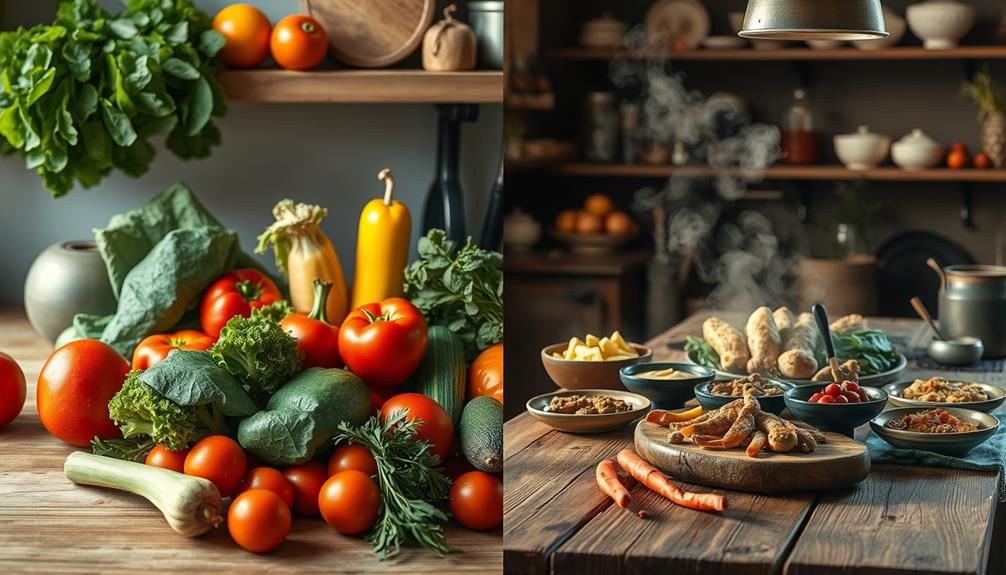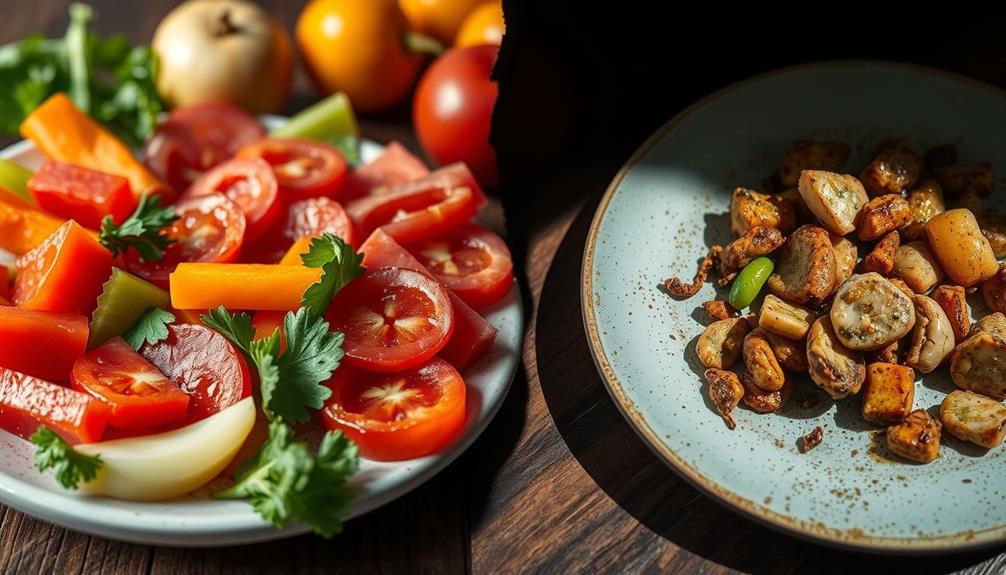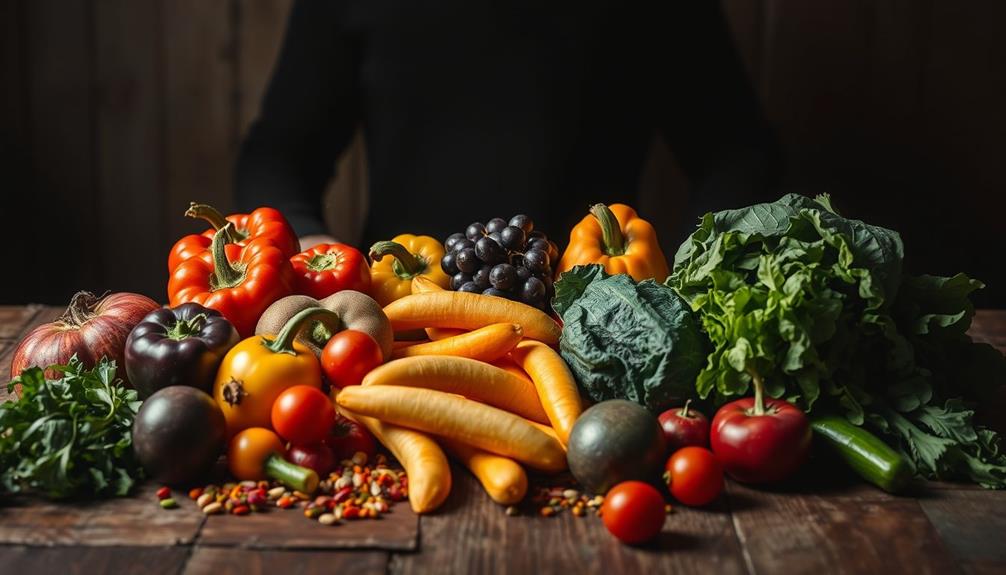You can expect significant weight loss on a raw food diet, often starting with 10-15 pounds in the first month. This initial loss is mainly water weight, but it can motivate you to stick with the plan. Over the next few months, you might lose a total of 5-20 pounds as your body adjusts. Long-term, some people report losses of 20-65 pounds within a year. Just remember, your results can vary based on individual factors like metabolism and adherence to the diet. There's much more to uncover about how to maximize your success and stay healthy on this journey. It’s also important to be aware of the potential risks of consuming raw food, such as the increased risk of foodborne illnesses like E. coli or salmonella. To minimize these risks, it’s crucial to thoroughly wash and prepare all raw fruits and vegetables, as well as consider incorporating other safe food handling practices. Additionally, consulting with a healthcare professional or registered dietitian before starting a raw food diet can help ensure that you are meeting your nutritional needs and avoiding any potential health concerns.
Key Takeaways
- Initial weight loss of 10-15 pounds is common in the first month due to low caloric intake and water weight loss.
- Long-term weight loss can range from 20 to 65 pounds over 6-12 months, depending on adherence and individual metabolism.
- Maintaining at least 70% of the diet as raw foods correlates with more effective weight loss results.
- Managing caloric intake and focusing on low-calorie, high-fiber foods are crucial for sustained weight loss.
- Potential nutrient deficiencies can arise without careful planning, highlighting the need for a balanced raw food diet.
Understanding the Raw Food Diet
Have you ever wondered what exactly the raw food diet entails? This diet primarily consists of unprocessed, whole plant-based foods like fruits, vegetables, nuts, seeds, and sprouted grains. The guideline is to consume at least 75% of your food raw or cooked at temperatures below 104-118°F (40-48°C).
Historical roots trace back to the mid-19th century, focusing on health motivations and the belief that raw foods offer higher nutritional value. Additionally, a raw food diet may include nutrient-rich options such as celery juice, known for its high levels of antioxidants and anti-inflammatory properties.
When you adopt a raw food diet, common food preparation methods include juicing, blending, soaking, and dehydrating, all aimed at preserving nutrients and enzymes. While you can explore variations like raw vegan or raw vegetarian, the essence remains the same: consuming raw or minimally processed foods.
Nutritional considerations are vital since this diet can lead to deficiencies in vitamin B12, calcium, and protein if not carefully planned. It's important to monitor your calorie intake and guarantee you're getting a balanced array of nutrients.
Embracing a raw food diet can offer numerous health benefits, but it requires thoughtful food preparation and awareness of your nutritional needs to thrive on this lifestyle.
Initial Weight Loss Expectations
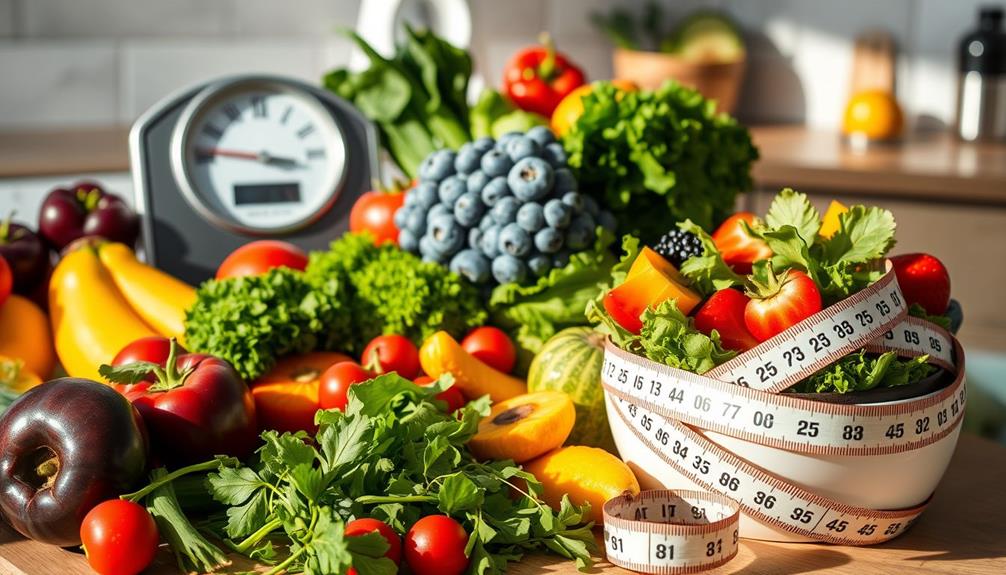
When you start a raw food diet, you might notice a significant change on the scale within the first month.
Initial weight loss can be influenced by various factors, including your metabolism and how strictly you stick to the diet.
Incorporating essential oils for overall wellness can also support your weight loss journey by enhancing your mood and energy levels.
Keep in mind that some of this early loss may just be water weight, but it can serve as a motivating start to your weight loss journey.
Weight Loss Timeline
Shifting to a raw food diet can lead to noticeable changes on the scale quite quickly. Many individuals experience initial weight loss of about 10-15 pounds in the first month due to the diet's low-caloric intake and high fiber content. Depending on your previous eating habits, you might lose anywhere from 5 to 20 pounds in the first few months.
As your body adjusts, you may find that weight loss stabilizes, resulting in a gradual loss of 1-2 pounds per week. Long-term adherents often report total weight losses ranging from 20 to 65 pounds over several months to a year.
Here's a simple timeline to give you an idea of what to expect:
| Time Frame | Expected Weight Loss |
|---|---|
| First Month | 10-15 pounds |
| 1-3 Months | 5-20 pounds total |
| Long-Term (6-12 months) | 20-65 pounds total |
Factors Influencing Results
Several factors can greatly influence your initial weight loss results on a raw food diet. You might experience initial weight loss ranging from 5 to 20 pounds in the first month, primarily due to reduced calorie intake and the elimination of processed foods.
Adopting a balanced diet rich in fruits and vegetables, as seen in lifestyle for longevity, can also enhance your overall health during this change. Your starting weight plays a significant role; heavier individuals often see more substantial early results.
Dietary adherence is essential, too — those who stick to a diet that's at least 70% raw have been known to lose weight more effectively than those who include cooked meals.
Your individual metabolism also impacts how quickly you shed pounds. Some people naturally burn calories faster, while others may take longer to see results.
Keep in mind that your initial weight loss often includes a mix of fat loss and water weight. Over time, if you remain committed, you could achieve total weight loss of 20 to 30 pounds or more within a year.
Ultimately, understanding these factors can help set realistic expectations as you commence your raw food journey.
Initial Water Weight
As you commence a raw food diet, it's common to experience significant initial weight loss, much of which comes from losing water weight. This rapid drop often occurs within the first week, with many individuals shedding between 5 to 10 pounds. The reason behind this is mainly the reduction in sodium intake and the increase in fruits and vegetables, which improves hydration and reduces water retention.
Additionally, the shift towards a diet rich in whole foods can enhance overall health and may even complement efforts to manage conditions like gout, where dietary choices play a vital role foods beneficial for managing gout symptoms.
The high fiber content of raw foods plays an essential role in promoting digestive regularity, helping your body eliminate excess water and waste. As you cut out processed foods, your body begins to adjust, leading to a further decrease in initial water weight.
While this early weight loss can be motivating, it's important to recognize that it primarily reflects changes in water levels rather than fat loss.
Over time, as your body adjusts to the raw food diet, you'll start to see gradual fat loss, distinct from the initial water weight. Many participants on raw vegan diets report average weight loss of 22 to 26 pounds over several months, but remember, the first few pounds are often just water.
Stay focused on long-term health benefits as your journey continues!
Long-Term Weight Loss Factors
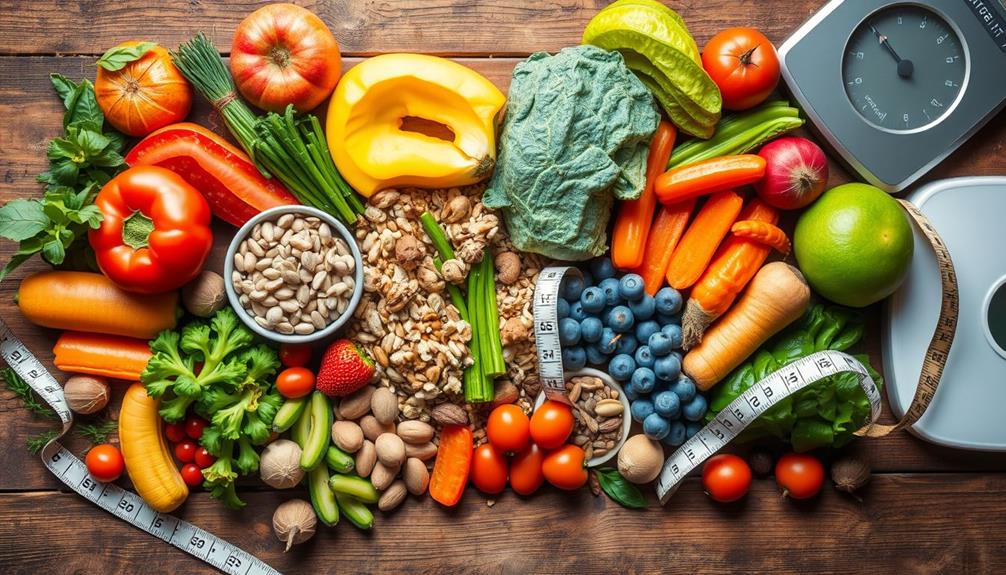
When you're on a raw food diet, managing your caloric intake is essential for achieving long-term weight loss.
It's important to guarantee you have a well-draining soil of nutrients, much like how plants thrive best in suitable environments.
You also need to focus on balancing your nutrients to support your body's needs.
Without careful planning, you might face energy dips and hinder your progress.
Caloric Intake Management
Caloric intake management plays an essential role in achieving long-term weight loss on a raw food diet. By focusing on high fiber foods like raw fruits and vegetables, you can promote satiety while consuming fewer calories overall. Incorporating essential oils for skin conditions may also support your health as you adapt to this diet.
Studies show participants on raw vegan diets often lose between 22 to 26 pounds over 3.5 years, largely due to the low-calorie nature of these foods. When you consume a diet that's at least 75% raw, you create significant caloric deficits, which aids in your weight loss journey.
However, proper management of caloric intake is vital. If you overconsume high-calorie raw foods like nuts and seeds, you may experience weight stabilization or even gain. Striking a careful balance of macronutrients while managing calories is necessary to avoid potential nutrient deficiencies.
This balance helps you achieve your desired weight loss goals without sacrificing your health. Remember, the raw food diet can be beneficial for weight loss, but only if you're mindful of your caloric intake and make informed choices. Stay focused on incorporating low-calorie, high fiber options for the best results.
Nutrient Balance Importance
Maintaining a balanced nutrient profile is essential for anyone on a raw food diet aiming for long-term weight loss. Without proper nutrient balance, you risk deficiencies in essential nutrients like protein, vitamin B12, calcium, and omega-3 fatty acids, which can hinder your weight loss efforts and lead to health complications.
Incorporating gentle stretching before bedtime can also help alleviate physical discomfort that might arise during your weight loss journey.
You should keep in mind:
- A well-planned diet guarantees adequate caloric intake to avoid muscle loss and a reduced metabolic rate.
- High fiber foods promote satiety but can cause digestive discomfort if you're not properly hydrated.
- Regularly monitoring your health metrics will help you catch any nutrient deficiencies before they escalate.
To achieve sustainable weight loss, consider balancing your raw food intake with occasional cooked foods. This approach can enhance nutrient absorption and promote overall dietary diversity.
Additionally, supplementation may be necessary to address specific nutrient gaps. By prioritizing nutrient balance, you'll not only support your weight loss journey but also safeguard your long-term health.
Emphasizing a diverse, nutrient-rich diet will help you thrive while pursuing your weight loss goals.
Nutritional Considerations
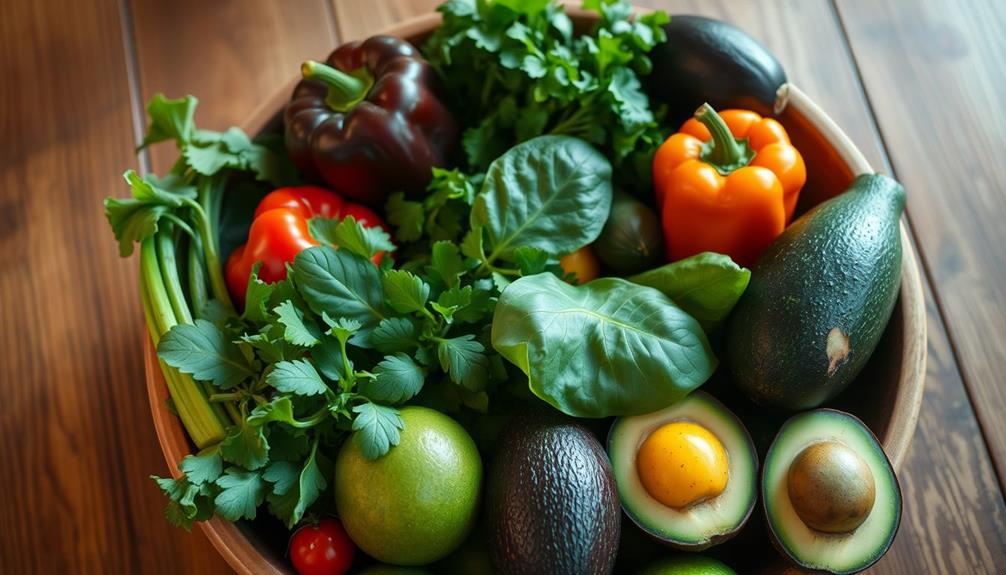
Understanding the nutritional factors of a raw food diet is fundamental for anyone looking to lose weight healthily. While a raw vegan diet can be advantageous, it often leads to potential nutrient deficiencies, especially in vitamin B12, calcium, and protein. Careful planning is important to guarantee you meet your daily nutritional needs.
To maintain a balanced diet, reflect on incorporating common financial terms related to budgeting and investing in your health, as prioritizing nutritional intake is a significant investment in your well-being.
If you're not careful with your caloric intake, you might experience weight loss, but it could come at a cost. Insufficient calories can lead to fatigue, decreased muscle mass, and hormonal imbalances, which are detrimental to your overall health. The high fiber content in raw foods can aid digestion and help regulate blood sugar levels, supporting weight management.
However, long-term adherence to a raw food diet may create nutritional imbalances. Studies show that raw dieters might've elevated homocysteine levels, negatively affecting heart health.
Additionally, you may need to reflect on supplementation for essential nutrients like omega-3 fatty acids and vitamin D, as these are often lacking in a raw vegan diet. Balancing these nutritional factors is crucial for sustainable weight loss and overall well-being.
Health Benefits of Raw Foods

When you switch to a raw food diet, you're tapping into a treasure trove of nutrients that can boost your health. Not only can this diet enhance your digestive health, but it also offers a solid potential for weight loss.
By focusing on whole, unprocessed foods, you're setting yourself up for better nutrient absorption and overall vigor.
Additionally, incorporating herbal teas like chamomile and ginger may further support your health by alleviating discomfort and promoting relaxation.
This holistic approach can contribute to a more balanced and energizing lifestyle.
Nutrient Density Advantage
The raw food diet's incredible nutrient density offers a wealth of health benefits that can transform your well-being. By focusing on fruits, vegetables, nuts, and seeds, you'll enjoy foods that aren't only delicious but also packed with essential nutrients.
This nutrient density means you can consume fewer calories while feeling full, contributing to effective weight loss. Additionally, exploring diverse food preparation methods can enhance your culinary experience and keep meals exciting, similar to how various brewing methods impact coffee enjoyment.
Consider these emotional benefits:
- Improved Energy Levels: With higher nutrient density, you'll likely notice a boost in your overall liveliness.
- Reduced Risk of Chronic Diseases: A diet rich in antioxidants and fiber can lower your chances of developing heart disease and type 2 diabetes.
- Enhanced Satiety: You'll feel satisfied longer, making it easier to stick to your weight loss goals.
Incorporating the raw food diet into your life allows you to enjoy the benefits of lower calorie intake without sacrificing nutrition.
As you consume more nutrient-dense foods, you'll experience a sense of fullness that curbs cravings and promotes healthier eating habits. Embracing this lifestyle not only supports weight loss but also nurtures your body, helping you thrive.
Enhanced Digestive Health
A raw food diet can greatly enhance your digestive health, making it easier to maintain a balanced and comfortable gut. Rich in dietary fiber, raw foods help alleviate issues like constipation and irritable bowel syndrome (IBS). This fiber supports the growth of beneficial gut bacteria, contributing to overall gut health.
Here's a quick comparison of raw food benefits:
| Benefit | Description |
|---|---|
| Enhanced Digestion | Improves breakdown of nutrients |
| Dietary Fiber | Alleviates constipation, supports gut health |
| Improved Digestive Regularity | Promotes consistent bowel movements |
| Low in Calories | Satisfies hunger with fewer calories |
| Nutrient Absorption | Enzymes in raw foods boost nutrient uptake |
Consuming a variety of raw foods leads to improved digestive regularity and reduced bloating, contributing to a sense of overall well-being. Plus, since many raw foods are low in calories but high in volume, they can aid in weight loss by promoting satiety. By embracing a raw food diet, you're not only focusing on enhanced digestion but also setting the stage for better gut health and nutrient absorption.
Weight Loss Potential
Many people find that adopting a raw food diet can greatly enhance their weight loss efforts. This diet typically leads to significant weight loss, with participants reporting losses of 10 to 26 pounds over several months. The secret lies in the lower calorie intake and high fiber content of nutrient-dense foods, which keeps you feeling full while minimizing overall caloric consumption.
Consider these benefits of a raw food diet:
- Improved digestion and gut health
- Lower body fat percentages
- Reduced risk of chronic diseases
By focusing on fruits and vegetables, you not only promote weight loss but also boost your overall health. The high fiber content aids digestion, allowing your body to absorb nutrients more effectively.
However, it's crucial to plan your meals carefully to avoid nutritional deficiencies that can hinder your weight loss efforts and overall well-being.
Potential Risks and Drawbacks
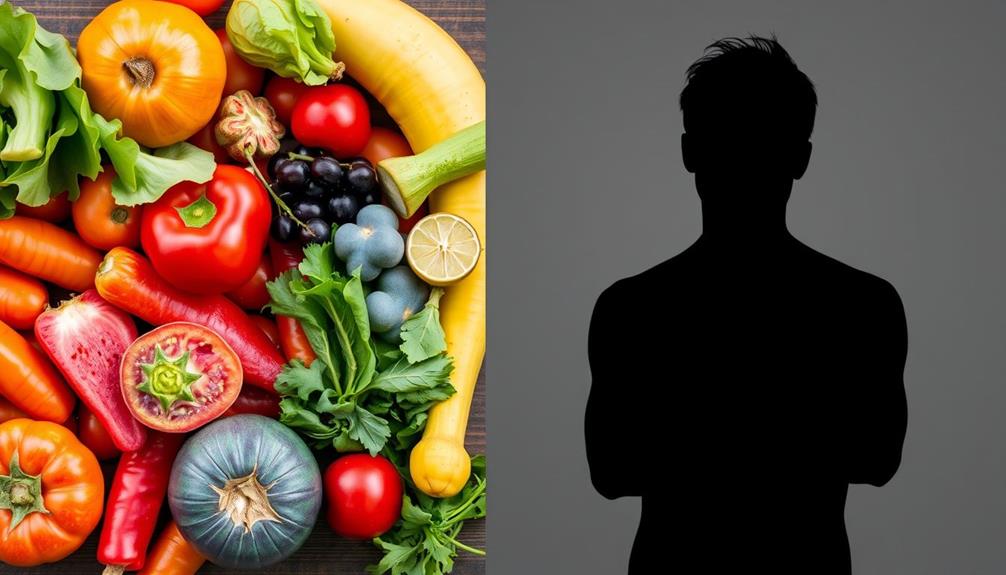
While embracing a raw food diet might seem like a healthy choice, it comes with several potential risks and drawbacks that shouldn't be overlooked.
One major concern is nutrient deficiencies. By excluding animal products and certain food groups, you could miss out on essential nutrients like vitamin B12, calcium, and omega-3 fatty acids. This can lead to health complications over time.
Moreover, significant weight loss may occur, potentially resulting in underweight conditions that can cause fatigue and muscle loss. You might also experience digestive issues, such as gas, bloating, and discomfort, which can be exacerbated by the high fiber content of raw foods.
Another risk is the increased exposure to harmful bacteria since cooking typically eliminates these pathogens. This can lead to foodborne illnesses that undermine your health.
Additionally, if you're not carefully planning your diet, you may experience elevated plasma homocysteine levels, a risk factor for cardiovascular diseases.
In short, while a raw food diet can offer benefits, it's vital to take into account these potential risks and guarantee that you're making informed dietary choices.
Impact on Mental Health
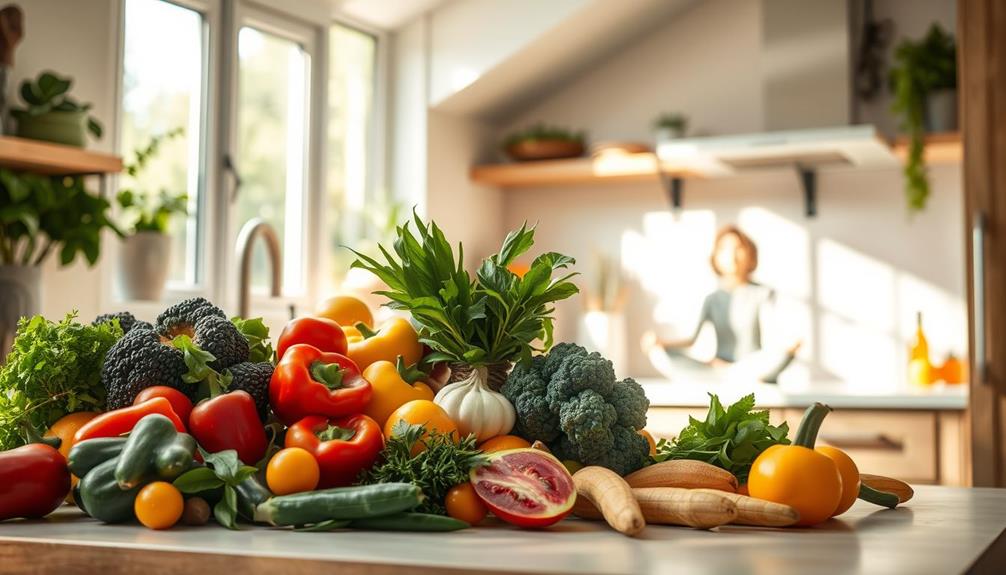
Although embracing a raw food diet can lead to various physical health benefits, it also considerably impacts mental health. Many individuals report improvements in mood and energy levels as they increase their intake of fresh fruits and vegetables. The rich vitamins and antioxidants found in these foods can enhance your mental well-being, while the high fiber content boosts gut health, facilitating better gut-brain communication.
You might experience:
- Increased energy and liveliness from nutrient-dense foods
- Enhanced mood and reduced anxiety due to higher vegetable and fruit consumption
- A sense of belonging and support from raw food communities
Despite these benefits, be aware that shifting to a raw food diet may cause temporary fatigue or irritability as your body withdraws from processed foods. However, these feelings usually pass as you adapt to your new eating habits.
Ultimately, this diet promotes a healthier mindset and can lead to a more positive outlook on life. Embracing fresh produce not only nourishes your body but also uplifts your spirit, making the journey toward better health a fulfilling experience.
Meal Planning Tips
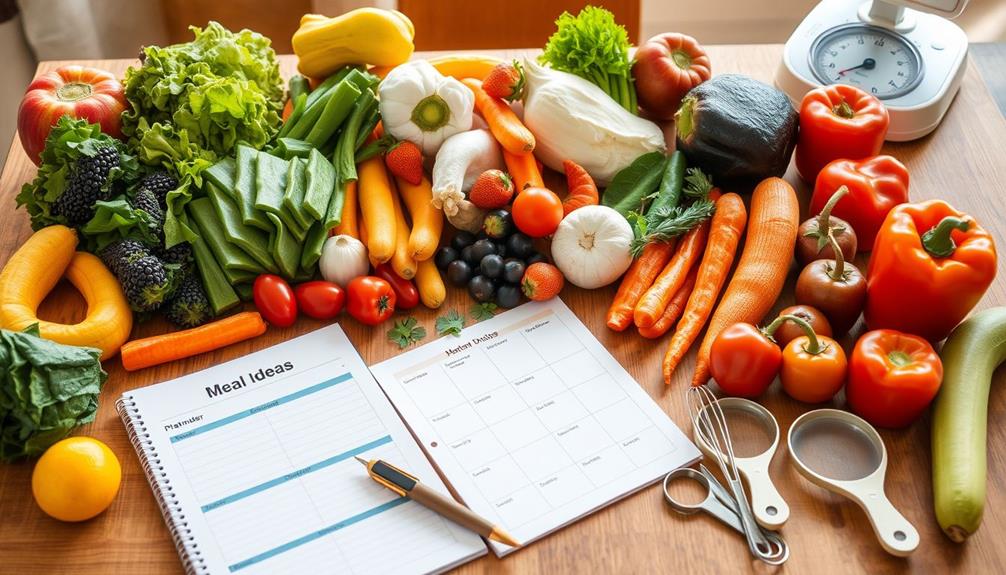
Planning meals for a raw food diet can make a significant difference in your success and enjoyment of this lifestyle. A well-structured meal plan should include at least 75% raw foods, such as fruits, vegetables, nuts, and seeds, to guarantee nutritional adequacy. Incorporate a variety of colors and types of produce to prevent nutrient deficiencies.
Here's a simple meal plan template to guide you:
| Meal | Raw Foods | Preparation Technique |
|---|---|---|
| Breakfast | Smoothie (banana, spinach) | Blend |
| Lunch | Salad (mixed greens, carrots) | Toss |
| Snack | Nut bars | No prep needed |
| Dinner | Zucchini noodles with sauce | Spiralize, marinate |
Utilizing meal prep techniques like soaking, sprouting, and dehydrating can enhance the digestibility of your raw foods. Planning around seasonal produce not only improves flavor but also supports sustainability. Don't forget to include raw snacks like energy balls between meals to maintain energy levels and curb hunger, which is essential for sticking to a low-calorie raw food diet.
Exercise and Weight Loss
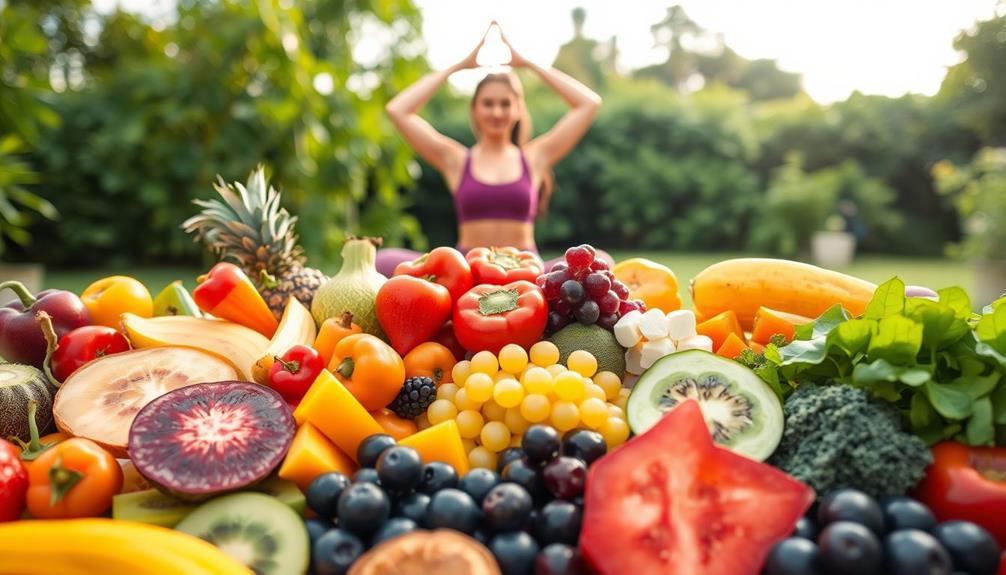
Integrating regular exercise into your routine can greatly boost the weight loss benefits of a raw food diet. By engaging in physical activities like yoga, cycling, or strength training, you'll increase your caloric expenditure, which can considerably enhance your weight loss journey.
Many individuals find that combining exercise with a raw food diet can lead to impressive results, often losing 10 to 25 pounds in the first few months.
Consider these emotional benefits of incorporating exercise:
- Increased energy levels that make daily tasks feel effortless
- Enhanced mood and reduced stress through endorphin release
- A stronger, more toned body that boosts self-confidence
Moreover, strength training is essential for maintaining muscle mass while you lose weight, ensuring that you're not just shedding pounds but also improving your body composition with lean muscle gain.
As your activity levels increase, you'll likely notice further weight reduction and overall improvements in your fitness.
Remember, a balanced approach combining a raw food diet and regular exercise not only aids in weight loss but also promotes better overall health and well-being.
Success Stories and Testimonials

Many people frequently share their inspiring success stories after adopting a raw food diet, illustrating the powerful impact it can have on weight loss and overall health.
For instance, participants have reported significant weight loss, with some shedding between 10 to 30 pounds over several months, depending on their individual metabolism and adherence to the diet.
Stevio's journey stands out, as he lost an impressive 65 pounds in a year, showcasing the potential for substantial long-term weight management.
Meanwhile, 3relefords experienced rapid results, dropping around 20 pounds in just two months. HolyGuacamole also highlighted impressive outcomes, achieving a weight loss of 10 pounds each month for the first two months.
Beyond weight loss, many have noted positive changes in body composition and energy levels.
Both Bitt and DagnyTaggart reported feeling more energetic and healthier overall, emphasizing that the raw food diet isn't just about shedding pounds; it's about fostering a lifestyle that promotes well-being.
These success stories serve as powerful motivation, proving that with commitment, you can experience significant weight loss and transformative health benefits on a raw food diet.
Frequently Asked Questions
How Much Weight Can I Lose on a Raw Food Diet?
You can lose anywhere from 5 to 20 pounds in the first few months on a raw food diet. Some experience initial losses of 10 to 15 pounds, depending on your adherence and lifestyle choices.
How Does Raw Food Diet Cause Weight Loss?
The raw food diet promotes weight loss by emphasizing whole, unprocessed foods, which are low in calories and high in fiber. You'll feel fuller longer, making it easier to maintain a caloric deficit without deprivation.
How to Lose Weight With Raw Food?
Imagine a vibrant garden, brimming with fresh fruits and vegetables. To lose weight with raw food, embrace this bounty, savoring colors and textures. Plan your meals, relish whole foods, and let nature guide your journey.
What to Expect When Switching to Raw Diet?
When you switch to a raw food diet, expect initial weight loss, digestive adjustments, and potential nutrient deficiencies. You may also notice changes in body composition and experience hormonal fluctuations as your body adapts.
Conclusion
In the journey of a raw food diet, you might find yourself shedding pounds like autumn leaves falling from trees. While initial weight loss can be swift, remember that lasting change blossoms over time with mindful choices. Nourishing your body with vibrant, fresh foods not only fuels your physical health but also brightens your mental landscape. Embrace the vibrant colors of whole foods, and watch as your energy flourishes, paving the way to a healthier, lighter you.

